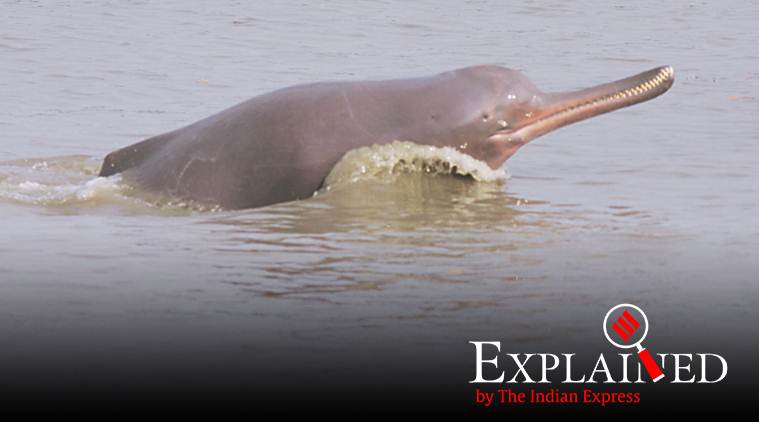Explained: Why India needs a Project Dolphin
There is an expectation that at the meeting a programme called “Project Dolphin”, along the lines of “Project Tiger” will be cleared to enhance the population of these dolphins.
By: Explained Desk | Updated: December 15, 2019 12:11:57 pm
The National Ganga Council (NGC), which is headed by Prime Minister Narendra Modi met for the first time at Kanpur on Saturday with the proposal to save and enhance the population of the Gangetic Dolphin, to discuss the concept of “River Cities” and an action plan to provide sewer connection to every household in towns along the Ganga and its tributaries.
The council consists of chief ministers from five states along the Ganga — Uttar Pradesh, West Bengal, Uttarakhand, Bihar and Jharkhand along with nine Union ministers and NITI Aayog vice-chairman. The central objective of the council is to work on the “protection, prevention, control and abatement of environmental pollution in River Ganga and its rejuvenation to its natural and pristine condition and to ensure continuous adequate flow of water”. The council is supposed to meet every year, but since its inception in 2016, no meeting has taken place.
There is an expectation that at the meeting a programme called “Project Dolphin”, along the lines of “Project Tiger” will be cleared to enhance the population of these dolphins.
The status of Gangetic dolphins in India
The Gangetic river dolphins were officially discovered in 1801 and are one of the oldest creatures in the world along with some species of turtles, crocodiles and sharks, according to the World Wildlife Fund (WWF). They once lived in the Ganges-Brahmaputra-Meghna and Karnaphuli-Sangu river systems of Nepal, India, and Bangladesh, but are now mostly extinct from many of its early distribution ranges, as per WWF.
In 2009, the Gangetic dolphins were declared India’s National Aquatic animal during the first meeting of the erstwhile National Ganga River Basin Authority (NGRBA) and it is placed under the “endangered” category by the International Union for Conservation of Nature (IUCN). The Gangetic river dolphins can only live in freshwater, are blind and catch their prey in a unique manner, using ultrasonic sound waves. These dolphins prefer deep waters and, as per WWF, they are distributed across seven states in India: Assam, Uttar Pradesh, Madhya Pradesh, Rajasthan, Bihar, Jharkhand and West Bengal.
Their numbers have dwindled in the last few decades mainly because of direct killing, habitat fragmentation by dams and barrages and indiscriminate fishing.
Gangetic dolphins in numbers
According to the Ministry of Environment, Forest and Climate Change, at last count, the rivers of Assam and Uttar Pradesh had 962 and 1,275 Gangetic dolphins, respectively. In Assam, the latest available data is for the period between January and March 2018, while the latest available data for UP is for the period between 2012 and 2015. In UP, 671 dolphins were recorded and in 2015, 1272 were recorded.
According to the ministry, in Assam, the assessment was carried out in three rivers, with the Brahmaputra accounting for 877 of the 962 dolphins in the state. In addition to the species being India’s national aquatic animal, the Gangetic dolphin has been notified by the Assam government as the state aquatic animal, too. Silting and sand lifting from rivers in Assam has been stopped to maintain its population.
As per WWF estimates, they number somewhere between 1200-1800.
What are some of the efforts made in India to protect the dolphins?
Some of the efforts made to preserve and increase the numbers of these dolphins include the setting up of the Conservation Action Plan for the Gangetic Dolphin (2010-2020), which has identified threats to Gangetic dolphins and impact of river traffic, irrigation canals and depletion of prey-base on dolphin populations.
Additionally, the Gangetic dolphins have been included in Schedule -I of the Wildlife Protection Act, 1972, which means they have the highest degree of protection against hunting. They are also one among the 21 species identified under the centrally sponsored scheme, “Development of Wildlife Habitat”

No comments:
Post a Comment